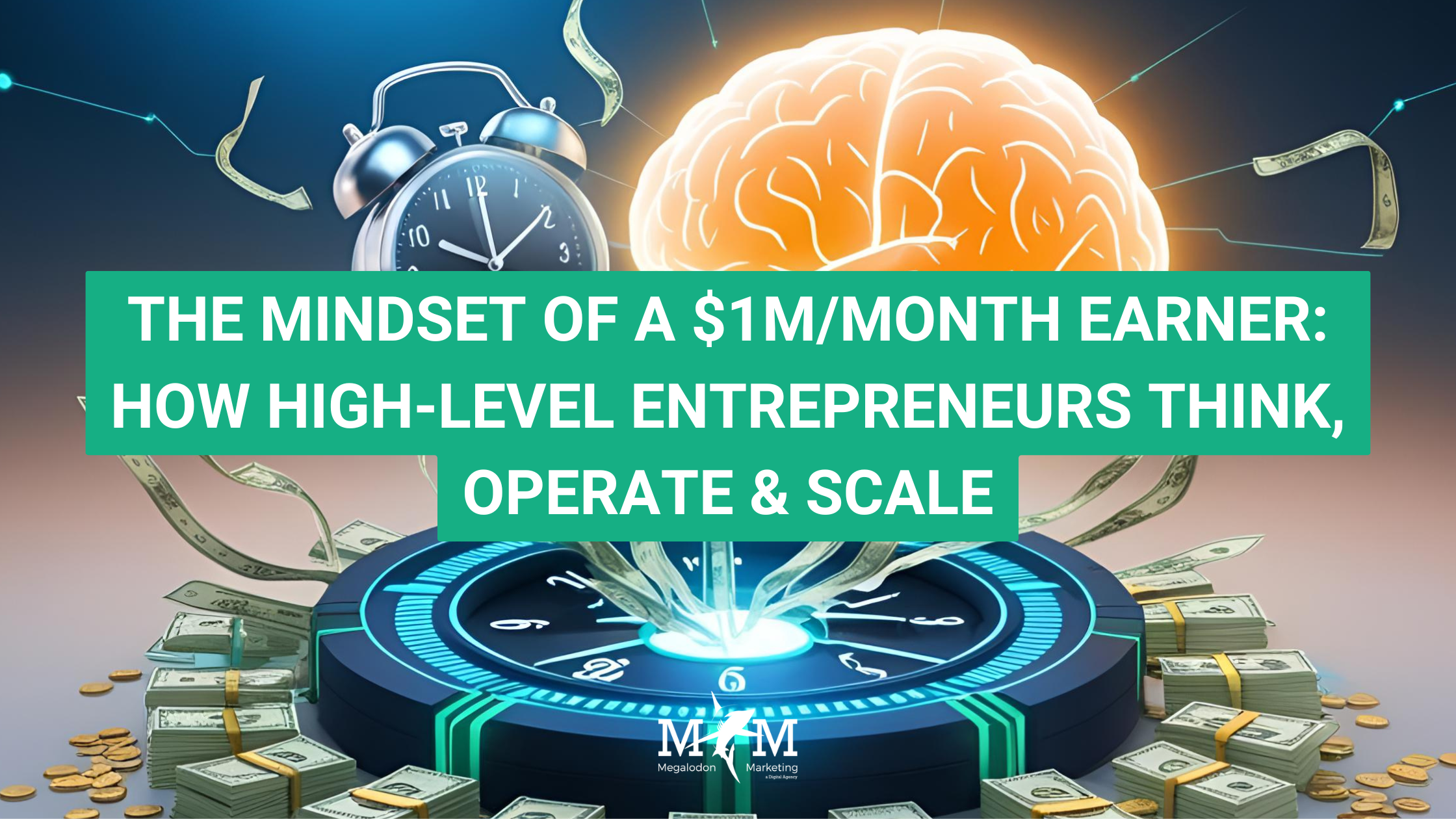I hope you enjoy reading this blog post. If you want my team to just do your marketing for you, click here.

I hope you enjoy reading this blog post. If you want my team to just do your marketing for you, click here.
Author: Jeremy Haynes | founder of Megalodon Marketing.

Earnings Disclaimer: You have a .1% probability of hitting million dollar months according to the US Bureau of Labor Statistics. As stated by law, we can not and do not make any guarantees about your own ability to get results or earn any money with our ideas, information, programs or strategies. We don’t know you and, besides, your results in life are up to you. We’re here to help by giving you our greatest strategies to move you forward, faster. However, nothing on this page or any of our websites or emails is a promise or guarantee of future earnings. Any financial numbers referenced here, or on any of our sites or emails, are simply estimates or projections or past results, and should not be considered exact, actual or as a promise of potential earnings – all numbers are illustrative only.
Watch the full video breakdown on this topic here.
These key takeaways reflect what separates a typical six-figure business owner from a professional operating at the million-dollar-per-month mark. Below, we dive into precisely how you can rewire your mindset to step into that elite category—using real-life examples of historical conquerors, modern-day innovators, and personal lessons from working with over 40 entrepreneurs who’ve scaled to a million a month.
If you look at entrepreneurs doing over $1,000,000 a month in revenue, you’ll see certain recurring patterns—far beyond typical surface-level productivity hacks. They have ways of thinking and behaving that catapult them to extreme results.
Here’s what it usually looks like: they don’t tolerate mediocre timelines, they refuse to compromise on big ideas, and they surround themselves with powerful mission-driven teams. Over and over, these individuals prove that it’s not random luck—they are systematically building their environment, their strategies, and their outlook to accomplish what most people believe is too ambitious or even unattainable.
I’ve personally had the privilege of helping over 40 people reach million-dollar months in their business, so I’ve been “under the hood” of what it takes to operate at that level. If you think it’s all about hustle alone, you’re missing the real secret sauce: efficiency, unwavering vision, and the ability to handle monumental pressure.
Below, I’m distilling some of the most essential traits I’ve observed and dissecting what it really means to “think bigger” than a seven-figure month.
Efficiency means putting in a smaller amount of time and resources but getting more output than anyone else around you. In everyday life, you might see people hustle all day and produce minimal results. Meanwhile, a truly elite operator might dedicate two or three focused hours and generate a larger outcome.
Elite entrepreneurs figure out how to constrain the hours they spend. Rather than working 18 hours on scattered tasks, they’ll work a shorter, hyper-focused chunk to knock out tasks it takes most people days or weeks to complete. For example, a typical million-dollar-a-month business owner might compress certain decisions into one day that most teams would spend an entire quarter debating.
Consider a high-level leader who intentionally schedules tight windows for major meetings. When you only allot 15 or 20 minutes, you force the entire team to cut the fluff and jump straight to solutions. The result? They solve more problems in less time.
Look at Napoleon or Elon Musk (we’ll go deeper on each in upcoming sections). They pulled off feats that most would label “impossible,” largely because they recognized that you can compress time if you remove the politics, fear, and bureaucratic nonsense that cause average people to drag their feet.
One core difference between those who stay stuck at lower revenue levels versus those who break through to $1,000,000 a month is how they respond to big, seemingly insurmountable goals. Average business owners say, “That can’t be done this quarter—maybe in a year or two.” High-level operators question that assumption, ask for solutions, and flat-out refuse to accept timelines that stretch into oblivion.
Most people rationalize why they haven’t taken a bigger risk or moved faster:
A million-dollar-a-month thinker flips it around and says, “If it had to happen in half the time, or even a third of the time, how would we do it?” They essentially delete the standard logic that says it must be slow. This triggers creative solutions that the typical person never even considers.
These individuals also don’t tolerate long-winded bureaucracy. If a person on the team keeps rehashing why it’s not possible, that person either pivots to a solution-oriented mindset or gets removed from the team altogether. There’s no room for negativity that isn’t rooted in fixable data.
I once visited the home of an entrepreneur doing over $3 million a month—someone who had already sold two companies for $54 million and $130 million respectively. Walking through his office, I noticed a near-obsessive level of decor related to Napoleon Bonaparte: paintings, documents, artifacts. Naturally, I asked him, “What’s the deal with all this Napoleon stuff?”
He explained that Napoleon represented a pinnacle of human achievement—someone who got more done in a few days than most men accomplish in multiple lifetimes. For instance, there’s a story about Napoleon going on a six-day “vacation,” during which he effectively overthrew a government, reformed local laws, and implemented sweeping changes that would typically require an entire career to accomplish. It was that level of extreme efficiency and audacity that my colleague sought to emulate in business.
High-level individuals constantly benchmark against the greatest doers in history—figures like Napoleon, Alexander the Great, or modern equivalents like Elon Musk. When you align your mindset with these unstoppable forces, you subconsciously raise your own ceiling for what you consider possible.
That same entrepreneur explained that he used Napoleon’s achievements as a daily reminder that the things most see as giant leaps are actually small steps when you adopt a broader perspective. Indeed, it dwarfs your “big goals” into something smaller, so you’re more likely to tackle them quickly instead of laboring slowly.
Elon Musk is a perfect modern example of what it means to dismantle excuses. Specifically, consider when Musk tasked a small team of physicists, rocket scientists, engineers, and mathematicians with building a massive rocket—capable of launching and then landing itself—on a six-month timeline.
That same team had come back to Musk, claiming it would take 10 years. Musk rejected it outright, effectively telling them: “I’d rather fire you all and start fresh than accept a 10-year timeline.”
In the standard aerospace world, a 10-year timeline wouldn’t shock anyone. But Musk’s entire approach is to challenge assumptions. He refused to let established “logic” be the final word.
Forced to brainstorm, the team started thinking radically differently. One physicist suggested simulating thousands of rocket launches and landings via Unreal Engine (a popular gaming engine known for real-world physics modeling). They hired a few game developers, built a hyper-accurate rocket environment with genuine laws of gravity, weight distributions, etc., and tested iteration after iteration in a fraction of the time.
They still took about 8 months total—longer than Musk’s ideal 6 months, but still drastically shorter than 10 years. The point isn’t that they did it exactly as Musk first insisted; it’s that they turned a “decade-long” project into something achievable in under a year simply by refusing to let “it can’t be done” stand in the way.
Building a rocket that can land itself—one the size of a skyscraper—was only a stepping stone for Musk’s ultimate vision: establishing a colony on Mars. Most people see a self-landing rocket as an end goal. Musk sees it as a piece of the puzzle, one crucial rung on the ladder to colonizing another planet. This is how the best entrepreneurs treat any big task: it’s never the final victory. It’s just one part of a colossal purpose.
Many aspiring business owners see $1 million a month as the pinnacle. They can’t imagine surpassing that. But those who do surpass it often view that accomplishment as merely one step in an even bigger plan.
No matter how miraculous it looks to the outside world, high-level thinkers place such accomplishments on the roadmap to something massively bigger. As soon as you treat something like $1 million months as the “holy grail,” it psychologically towers over you. But when it’s just a rung on the ladder, it feels more accessible—inevitable, even.
Picture someone who’s obsessed with the idea of, “If I just get to seven figures monthly, I can buy extra houses, fancy cars, or a watch collection.” That’s fine, but it rarely powers you through the tough times. The bigger vision isn’t just about fancy possessions; it’s about creating a substantial shift in your industry or fulfilling a mission that others might label insane. It’s that bigger mission that compels you to tackle deadlines 10x faster than normal.
Let’s be real: a million-dollar-month earner absolutely cares about money. They’re not shy or apologetic about that. Yet if you dig beneath the surface, you find that, for them, money is essentially stored energy. It’s the fuel that speeds up everything they need to build.
When you have a war chest of funds, you solve problems in days that might otherwise take months or years. For a business with minimal capital, even a small hiccup—like a broken vehicle—becomes a multi-week fiasco. With sufficient financial resources, that same hiccup is solved the day it appears, with minimal disruption.
Wealthy entrepreneurs don’t see revenue generation as purely a scoreboard. They leverage those large incomes to expand faster, hire specialized talent, and invest in advanced tools. The bigger the mission, the more money you need to compress timelines. That’s why the million-dollar-a-month crowd is “money-hungry,” but in a strategic way that ties directly into a broader plan.
Another unifying trait of the million-a-month club is that their ventures almost always have a strong sense of mission. This goes beyond fluffy marketing jargon; it’s an underlying ethical driver to get their product or service into people’s hands because they genuinely believe it will create a positive ripple effect.
Silicon Valley culture is often mocked for lofty lines like, “We want to make the world a better place.” Yet the truly huge successes often come from founders who do believe in that ethos—who see a moral duty to spread their software or hardware to as many people as possible. They tie their corporate performance to the real-world impact on consumers or society.
When these founders or CEOs fail to hit a revenue target, it’s not just disappointment over money. They see it as lost momentum in fulfilling that bigger ethical responsibility. It’s a powerful frame that injects urgency and passion into hitting your numbers. You’re not only building personal wealth; you’re fueling a mission that makes a tangible difference.
Early in my career, I had a job with a prolific real estate mogul and sales trainer. I was 19 years old. This was my second marketing job, and it shaped how I view purpose-driven business.
Every morning at 9:00 a.m., the team had a meeting. We’d sort through hundreds (sometimes thousands) of testimonials and success stories from people who had read the guy’s books, taken his courses, or used his materials. We then shared the most impactful ones, day after day. It was impossible not to internalize how our products and services genuinely changed lives.
That constant reminder of how our work improved outcomes for others created a massive sense of urgency and pride. We knew that if we missed a marketing milestone or let sales slip, we were directly limiting the number of people who could benefit.
This daily immersion forged a culture where “making more money” meant “expanding our positive influence.” In other words, the bigger we got, the faster we grew, the more people we could help. That synergy between financial success and meaningful impact supercharges an organization to hit extraordinary revenue goals consistently.
Contrary to the common assumption, these million-dollar earners don’t lounge around once they reach the seven-figure monthly mark. They remain in a self-imposed “high-pressure” environment. Comfort is the last thing on their minds.
Yes, they might have multiple houses, multiple luxury cars, and a suite of staff to handle personal chores. But in their work life, they set ambitions so colossal that the default state is constant adaptation and problem-solving. They force themselves to aim for compressed timelines, to find advanced talent, to remove anyone from the team who slows the progress. This consistent tension is how they continue scaling.
I’ve often discussed “Tweaker Mode” as a mindset. It’s where you relentlessly fine-tune every aspect of your business processes, marketing, and product development. You keep going until even the most daunting challenges break under your solutions. This means being unsatisfied with moderate improvements; you always push for the next best iteration.
In this environment, every team member—especially the leader—accepts full accountability for results. Problems cannot linger or be excused; they must be attacked vigorously. If someone blocks the path, that person is replaced by someone who shares the same no-excuses mindset.
To truly align yourself with the million-dollar-a-month mindset, you have to transform how you view big projects, obstacles, and timelines. The playbook is clear:
When you adopt these principles, you’ll notice that scaling to a million-dollar month is far less intimidating—because you’re not fixated on it as the ultimate mountain peak. Instead, it becomes a logical checkpoint on the path to something even bigger. If you keep your eyes on that grander mission, you’ll dwarf every “giant challenge” along the way and move faster than you ever thought possible.
This approach is the unifying thread among every high-level entrepreneur I’ve had the privilege to work with. They do love money, but they love speed and impact even more. And the good news is, when you start to think and operate in these ways—like the Napoleons, the Elons, and all those unstoppable million-dollar-a-month earners—you’ll realize that impossible timelines shrink, your output skyrockets, and scaling quickly becomes the new normal.
So take these insights, embed them into your daily life, and let them fuel your journey. Whether you’re currently at $10,000 a month, $100,000 a month, or nearing $1 million a month, these core mindsets will accelerate your climb and redefine what’s truly achievable in your world.

Jeremy Haynes is the founder of Megalodon Marketing. He is considered one of the top digital marketers and has the results to back it up. Jeremy has consistently demonstrated his expertise whether it be through his content advertising “propaganda” strategies that are originated by him, as well as his funnel and direct response marketing strategies. He’s trusted by the biggest names in the industries his agency works in and by over 4,000+ paid students that learn how to become better digital marketers and agency owners through his education products.

Jeremy Haynes is the founder of Megalodon Marketing. He is considered one of the top digital marketers and has the results to back it up. Jeremy has consistently demonstrated his expertise whether it be through his content advertising “propaganda” strategies that are originated by him, as well as his funnel and direct response marketing strategies. He’s trusted by the biggest names in the industries his agency works in and by over 4,000+ paid students that learn how to become better digital marketers and agency owners through his education products.
This site is not a part of the Facebook website or Facebook Inc.
This site is NOT /endorsed by Facebook in any way. FACEBOOK is a trademark of FACEBOOK, Inc.
We don’t believe in get-rich-quick programs or short cuts. We believe in hard work, adding value and serving others. And that’s what our programs and information we share are designed to help you do. As stated by law, we can not and do not make any guarantees about your own ability to get results or earn any money with our ideas, information, programs or strategies. We don’t know you and, besides, your results in life are up to you. Agreed? We’re here to help by giving you our greatest strategies to move you forward, faster. However, nothing on this page or any of our websites or emails is a promise or guarantee of future earnings. Any financial numbers referenced here, or on any of our sites or emails, are simply estimates or projections or past results, and should not be considered exact, actual or as a promise of potential earnings – all numbers are illustrative only.
Results may vary and testimonials are not claimed to represent typical results. All testimonials are real. These results are meant as a showcase of what the best, most motivated and driven clients have done and should not be taken as average or typical results.
You should perform your own due diligence and use your own best judgment prior to making any investment decision pertaining to your business. By virtue of visiting this site or interacting with any portion of this site, you agree that you’re fully responsible for the investments you make and any outcomes that may result.
Do you have questions? Please email [email protected]
Call or Text (305) 704-0094